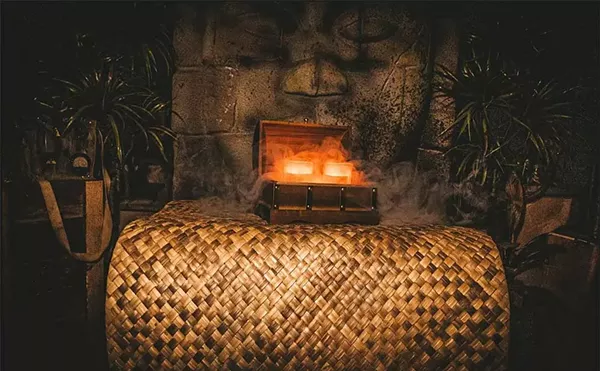
Audio By Carbonatix
[
{
"name": "GPT - Leaderboard - Inline - Content",
"component": "35519556",
"insertPoint": "5th",
"startingPoint": "3",
"requiredCountToDisplay": "3",
"maxInsertions": 100,
"adList": [
{
"adPreset": "LeaderboardInline"
}
]
}
]
The first time a hunter told me that wild turkeys fly low to the ground and as fast as a rocket, I thought he’d spent more time in the beer trailer than the brush. It also sounded like an alibi for the fact that he never seemed to come home with anything but an empty bag in turkey season.
Rely on friends like that for good table grub, and you’ll end up grubbing for grubs.
So the only turkeys I knew until successfully finagling my way into the food-writing racket — and the wonders that issue forth from kitchens in places most of us can never routinely afford to trespass — were those chesty critters pumped full of butter-like additives and, as we all eventually learned, antibiotics and other crap that would make the birds healthier but play hell with our own future well-being.
So Thanksgiving was most often a time of dry white meat and skimpy dark, both generally held in less favor than oyster stuffing, fresh cranberry sauce, giblet-and-neck gravy, mashed potatoes, biscuits, sweet corn casserole, outrageously candied sweet potatoes, various squash dishes and whatever else could be ram-fed into one’s gaping maw.
This situation is generally not the fault of the cook, but the preponderance of cooks who, in the good life that followed World War II and the attendant industrialization of food, insisted on more and more white meat on their turkeys. The better to please slobs like me, who want their white-meat turkey sandwiches once the main event is finished. (As a kid, I once downed three thick-uns within an hour of getting up from the feast table; heavy on the Miracle Whip and black pepper. A minor legend was born.)
Agribusiness responded by messing with a breed called the Broad-Breasted Bronze until its chest mutated into something worthy of star treatment in a Russ Meyer flick. But it could no longer breed — too much meat getting in the way of bumping uglies — and had to be artificially inseminated (with a turkey baster?). Its once long, muscular gams degenerated into squat little pins that could scarcely bear its freakish weight. And it was grounded for all time.
Because these mutants had to be produced at a fast, all-American clip, they were fed prodigious amounts of grain (producing a uniformly bland taste) on cramped lots and sent to market in a matter of months. They were given no time to add a proper layer of fat, so they cooked up dry. Buttery chemicals were used to address that, and the people said, “Mmmmmm.” But things still weren’t quite right, so turkey-cooking “hotlines” were established to help the masses make the best of a bad thing. But there was a lot of it, and every year, pre-holiday, supermarkets run specials on rock-solid turkeys for pennies a pound. It’s significant that they never say how long the birds have been frozen.
So this, the turkey, is the bird that Benjamin Franklin seriously proposed for the lofty position now long held by the bald eagle? What could he have been thinking — or drinking? The answer has nothing to do with Franklin’s state of mind. We simply don’t know Ben’s turkey that, for starters, and unlike the eagle, is native to North America. (It made it to European tables many centuries ago by way of the globe-trotting Spanish, but it was found here.)
It’s hard to argue that the wild turkey has the same sense of majesty as Big Bald, but it’s still a hell of a bird. Sleek and athletically proportionate, it struts with long, well-muscled legs and flies with enough speed and stealth even in thick forests that perplexed hunters admit defeat and drown their frustration in the powerful bourbon named for their clever quarry.
Considering the limited numbers of “heritage turkeys” — carefully husbanded wild breeds — and predictions that the freak birds we’ve consumed for about a half-century may well not survive the stresses of their biochemically altered bods for another, it would serve us well to get acquainted with the real deal.
I’ve eaten such turkeys twice, and the most noticeable difference is flavor. It’s not gamy; there’s just more of it. The legs are meatier and the breast isn’t nearly as large, but naturally juicier if handled properly in the kitchen.
Brining, the saltwater-soak technique that’s gotten so popular in recent years as just the latest attempt to make dry turkeys juicy, isn’t necessary with wild turkey breeds, and can thin out the flavor if done improperly.
If you find one sold commercially, or know a very good and generous turkey hunter, take these two tips (which are also worth using on Ol’ Chesty):
• Instead of covering the breast with aluminum foil during part of the roasting period, use cotton cloth or a triple layer of cheesecloth soaked in vegetable or olive oil. The foil traps moisture and steams the breast rather than roasting it, with the added disadvantage of decidedly uncrispy skin.
• Get a meat thermometer. Instant-read is best, they don’t cost much, and it’ll be some of your best-spent cooking money. Roast the turkey until the thermometer reads about 147 degrees when stuck into the thickest part of the thigh, then let it rest out of the oven for about 15 or 20 minutes. The pressurized interior heat of the bird will continue to cook it until the temperature is a desirable 160 to 170.
Learn much more, including how to fireplace-roast birds spinning from oiled string, at WilliamRubel.com. If you’re intrigued enough to pay extra for a much tastier, healthier bird, you can buy heritage turkeys from the nice folks at Ann Arbor’s Harnois Farm, 734-449-7172 or deadend@umich.edu, for about $5.25 a pound. The price at ExoticMeats.com is $2 more per pound, but you’ll also find what you’re need to appease that special hunger for ground yak.
Ric Bohy is editor of Metro Times. Send comments to rbohy@metrotimes.com




